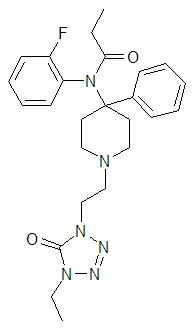Trefentanil
Trefentanil is a potent synthetic opioid that is part of the fentanyl family of drugs. It is primarily used in the medical field for its analgesic properties. Trefentanil is approximately five to ten times more potent than its parent compound, fentanyl.
Chemistry[edit | edit source]
Trefentanil is a 4-anilidopiperidine derivative, which is a structural feature shared with other synthetic opioids in the fentanyl family. The chemical structure of trefentanil includes a phenethyl group, which is believed to contribute to its high potency.
Pharmacology[edit | edit source]
Trefentanil acts primarily on the mu-opioid receptor, which is the primary site of action for most opioid drugs. Activation of the mu-opioid receptor leads to analgesia, sedation, and euphoria. Trefentanil also has some activity at the kappa and delta opioid receptors, but this is much less pronounced than its activity at the mu receptor.
Medical Use[edit | edit source]
Due to its high potency, trefentanil is typically used in a hospital setting for severe pain management. It is often used in conjunction with other medications for anesthesia during surgery. The drug has a rapid onset and short duration of action, which makes it useful for procedures that require quick recovery times.
Side Effects[edit | edit source]
Like other opioids, trefentanil can cause a range of side effects. These can include respiratory depression, nausea, vomiting, and constipation. More serious side effects can include dependence and overdose, which can be fatal.
Legal Status[edit | edit source]
Trefentanil is a controlled substance in many countries due to its high potential for abuse and dependence. In the United States, it is classified as a Schedule II drug under the Controlled Substances Act.
See Also[edit | edit source]
Search WikiMD
Ad.Tired of being Overweight? Try W8MD's physician weight loss program.
Semaglutide (Ozempic / Wegovy and Tirzepatide (Mounjaro / Zepbound) available.
Advertise on WikiMD
|
WikiMD's Wellness Encyclopedia |
| Let Food Be Thy Medicine Medicine Thy Food - Hippocrates |
Translate this page: - East Asian
中文,
日本,
한국어,
South Asian
हिन्दी,
தமிழ்,
తెలుగు,
Urdu,
ಕನ್ನಡ,
Southeast Asian
Indonesian,
Vietnamese,
Thai,
မြန်မာဘာသာ,
বাংলা
European
español,
Deutsch,
français,
Greek,
português do Brasil,
polski,
română,
русский,
Nederlands,
norsk,
svenska,
suomi,
Italian
Middle Eastern & African
عربى,
Turkish,
Persian,
Hebrew,
Afrikaans,
isiZulu,
Kiswahili,
Other
Bulgarian,
Hungarian,
Czech,
Swedish,
മലയാളം,
मराठी,
ਪੰਜਾਬੀ,
ગુજરાતી,
Portuguese,
Ukrainian
Medical Disclaimer: WikiMD is not a substitute for professional medical advice. The information on WikiMD is provided as an information resource only, may be incorrect, outdated or misleading, and is not to be used or relied on for any diagnostic or treatment purposes. Please consult your health care provider before making any healthcare decisions or for guidance about a specific medical condition. WikiMD expressly disclaims responsibility, and shall have no liability, for any damages, loss, injury, or liability whatsoever suffered as a result of your reliance on the information contained in this site. By visiting this site you agree to the foregoing terms and conditions, which may from time to time be changed or supplemented by WikiMD. If you do not agree to the foregoing terms and conditions, you should not enter or use this site. See full disclaimer.
Credits:Most images are courtesy of Wikimedia commons, and templates, categories Wikipedia, licensed under CC BY SA or similar.
Contributors: Prab R. Tumpati, MD

